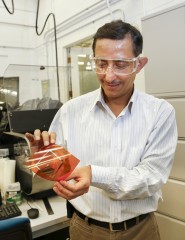Innovative, Lower Cost Sensors and Controls Yield Better Energy Efficiency

ORNL ORNL researchers are experimenting with additive roll-to-roll manufacturing techniques to develop low-cost wireless sensors. ORNL’s Pooran Joshi shows how the process enables electronics components to be printed on flexible plastic substrates.
Buildings are responsible for about 40 percent of the energy consumed in the United States. Studies indicate that advanced sensors and controls have the potential to reduce the energy consumption of buildings by 20-30 percent.
“It is widely accepted that energy-consuming systems such as heating, ventilating, and air conditioning (HVAC) units in buildings are under, or poorly, controlled causing them to waste energy,” said Patrick Hughes, director of ORNL’s Building Technologies Program. “Buildings could increase their energy efficiency if control systems had access to additional information.”
Collecting data such as outside air and room temperature, humidity, light level, occupancy and pollutants is currently cost prohibitive, whether the information is gathered by inexpensive conventional sensors that must be wired, or by using today’s expensive $150-300 per node wireless sensors.
ORNL’s new wireless sensor prototype could reduce costs to $1-10 per node by leveraging advanced manufacturing techniques such as additive roll-to-roll manufacturing. This process enables electronics components like circuits, sensors, antennae, and photovoltaic cells and batteries to be printed on flexible plastic substrates (base materials). The nodes can be installed without wires using a peel-and-stick adhesive backing.
“If commercially available at the target price point, there would be endless application possibilities where the installed cost to improve the control of energy-consuming systems would pay for itself through lower utility bills in only a few years,” Hughes said.
The ultra-low power smart sensors collect and send data to a receiver, which can capture data from many different peel-and-stick nodes and provide the information to the energy-consuming system. The more information received, the better the building’s energy management.
Both new construction and retrofitted buildings can benefit from ORNL’s smart sensors.
“This technology provides the information that enables ongoing continuous commissioning, fault detection and diagnosis, and service organization notifications when needed, ensuring optimal building system operations throughout their service life,” said ORNL’s Teja Kuruganti, principal investigator on the low-cost wireless sensors project.
ORNL is currently in negotiations to establish a cooperative research and development agreement with a premier international electronics manufacturer to make the low-cost wireless sensors commercially available.
This project is sponsored by DOE’s Building Technologies Office in DOE’s Office of Energy Efficiency and Renewable Energy.
UT-Battelle manages ORNL for the Department of Energy’s Office of Science. The Office of Science is the single largest supporter of basic research in the physical sciences in the United States, and is working to address some of the most pressing challenges of our time. For more information, please visit http://science.energy.gov/
Sara Shoemaker, shoemakerms@ornl.gov
Media Contact
All latest news from the category: Power and Electrical Engineering
This topic covers issues related to energy generation, conversion, transportation and consumption and how the industry is addressing the challenge of energy efficiency in general.
innovations-report provides in-depth and informative reports and articles on subjects ranging from wind energy, fuel cell technology, solar energy, geothermal energy, petroleum, gas, nuclear engineering, alternative energy and energy efficiency to fusion, hydrogen and superconductor technologies.
Newest articles

Bringing bio-inspired robots to life
Nebraska researcher Eric Markvicka gets NSF CAREER Award to pursue manufacture of novel materials for soft robotics and stretchable electronics. Engineers are increasingly eager to develop robots that mimic the…

Bella moths use poison to attract mates
Scientists are closer to finding out how. Pyrrolizidine alkaloids are as bitter and toxic as they are hard to pronounce. They’re produced by several different types of plants and are…

AI tool creates ‘synthetic’ images of cells
…for enhanced microscopy analysis. Observing individual cells through microscopes can reveal a range of important cell biological phenomena that frequently play a role in human diseases, but the process of…





















